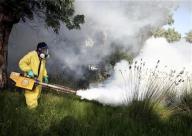It's not always influenza that kills, part 2
 Dengue Fever is headed to the United States.
Dengue Fever is headed to the United States.
From Bloomberg.com: http://www.bloomberg.com/apps/news?pid=20601087&sid=aWqWwATk6DpA&refer=home
Dengue Fever Threatens U.S. as Tropical Bugs Spread (Update2)
By Catherine Larkin
Jan. 8 (Bloomberg) -- Dengue fever, a potentially deadly virus usually found in the tropics, could begin spreading widely in the U.S. as mosquitoes that transmit the disease move into more states, according to two leading epidemiologists.
The disease has already struck Hawaii, Texas and Puerto Rico after decades of absence in the U.S., Anthony Fauci, director of the National Institute of Allergy and Infectious Diseases, and colleague David Morens write in the Jan. 9 Journal of the American Medical Association. They expect the threat to persist with increased air travel and urban development.
More than 760,000 cases of dengue and almost 20,000 cases of its deadly form, dengue hemorrhagic fever, were reported in the Americas in the first 11 months of last year, according to the Pan American Health Organization. With no specific treatments or proven vaccines to prevent the infection, an outbreak could overwhelm communities, Fauci and Morens said.
``This is an important problem, and our options for control and prevention at the moment are not very good,'' said Morens, Fauci's senior scientific adviser, in a phone interview today. ``It's easy to forget when a disease has been away for a long period of time.''
Dengue can be caused by four kinds of flavivirus, a family of viruses that also includes yellow fever and West Nile. The Aedes mosquitoes that transmit dengue have been around for hundreds of years and have re-emerged in greater numbers since efforts to prevent yellow fever waned in the 1970s, according to the U.S. Centers for Disease Control and Prevention.
Climate-Change Effect
Increases in rainfall, temperature and humidity caused by global warming also favor the spread of mosquitoes. These types of weather changes may more than double the number of people exposed to dengue worldwide by 2080, according to the United Nations' 2007-2008 Human Development Report.
The World Health Organization estimates that more than 50 million cases of dengue infection occur each year. The flu-like illness leads to about 500,000 hospitalizations, mostly in children, and at least 2.5 percent of patients die.
Symptoms include high fever, headaches, joint and muscle pain, vomiting and a rash. Usually people with dengue recover within two weeks, according to the National Institutes of Health. The infection can be life-threatening when it turns into dengue hemorrhagic fever, which causes bleeding from the nose, gums or under the skin, or dengue shock syndrome, which causes massive bleeding and shock, according to the NIH.
The National Institute of Allergy and Infectious Diseases, based in Bethesda, Maryland, allocated $33.2 million in the fiscal year ended Sept. 30 for research on dengue and the development of vaccines, medicines and tools to diagnose the disease, according to a statement released today.
To contact the reporter on this story: Catherine Larkin in Washington at clarkin4@bloomberg.net .
And from Reuters: http://www.reuters.com/article/scienceNews/idUSN0847856420080108?feedType=RSS&feedName=scienceNews
Tropical dengue fever may threaten U.S.: report
WASHINGTON, Jan 8 (Reuters) - Dengue fever -- a tropical infection that usually causes flu-like illness -- may be poised to spread across the United States and urgent study is needed, health officials said on Tuesday.
Cases of the sometimes deadly mosquito-borne disease have been reported in Texas and this may be the beginning of a new trend, said Dr. Anthony Fauci, director of the National Institute of Allergy and Infectious Diseases, and his senior scientific adviser, Dr. David Morens.
A warming climate and less-than-stellar efforts to control mosquitoes could accelerate its spread northwards, they cautioned.
"Widespread appearance of dengue in the continental United States is a real possibility," they wrote in a commentary in the Journal of the American Medical Association.
"Worldwide, dengue is among the most important reemerging infectious diseases, with an estimated 50 to 100 million annual cases, 500,000 hospitalizations and, by World Health Organization estimates, 22,000 deaths, mostly in children."
They compared dengue to West Nile virus, which first appeared in New York in 1999 and has now spread to the entire continental United States, Canada and Mexico. West Nile killed at least 98 people in the United States last year.
Both viruses are carried by mosquitoes. Dengue can be carried by the Aedes albopictus or Asian tiger mosquito -- first seen in 1985 in the United States -- as well as the more common Aedes aegypti species.
Most people infected with a dengue virus have no symptoms or a mild fever. It can cause minor bleeding from the nose or gums, but can also cause severe fever and shock and without treatment can kill.
"The combined effects of global urbanization and increasing air travel are expected to make dengue a growing international health problem for the foreseeable future," Fauci and Morens wrote.
(Reporting by Maggie Fox; editing by Julie Steenhuysen and Todd Eastham)
Could Florida and the Southeastern United States be added to the list soon, because of the proximity to the Caribbean, cruise ship passengers being bitten and taking the virus home to their home states, combined with the resurgence of Dengue in Puerto Rico? Unknown but quite possible. Perhaps even likely. We certainly don't suffer from a lack of mosquito activity. And look at the epidemics of norovirus that rage routinely now on cruise ships everywhere. Maybe that DEET repellent should be required slathering when passengers disembark at tropical ports, especially San Juan, Puerto Rico.

Reader Comments (1)
Dengue is curable in the Philippines. See http://www.denguecure.com